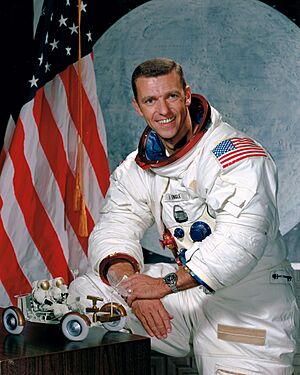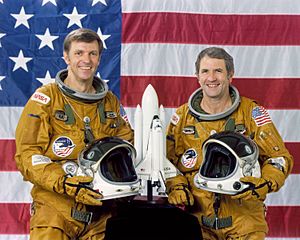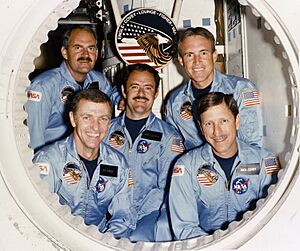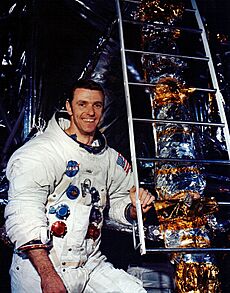Joe Engle facts for kids
Quick facts for kids
Joe Engle
|
|
|---|---|

Engle in 1971
|
|
| Born |
Joe Henry Engle
August 26, 1932 Chapman, Kansas, U.S.
|
| Died | July 10, 2024 (aged 91) |
| Awards | Distinguished Flying Cross NASA Distinguished Service Medal |
| Space career | |
| NASA astronaut | |
| Rank | Major General, USAF/ANG |
|
Time in space
|
9d 8h 30m |
| Selection | NASA Group 5 (1966) |
| Missions |
|
|
Mission insignia
|
|
| Retirement | November 28, 1986 |
Joe Henry Engle (born August 26, 1932 – died July 10, 2024) was an amazing American pilot, aeronautical engineer, and NASA astronaut. He commanded two Space Shuttle missions, including STS-2 in 1981. This was only the second time the Space Shuttle flew into orbit! He also helped test the Space Shuttle by flying it during its 1977 Approach and Landing Tests.
Joe was also one of only twelve pilots to fly the super-fast North American X-15. This was an experimental spaceplane used by the Air Force and NASA. He flew the X-15 above 50 miles (80 km) three times, which earned him special astronaut wings. In 1966, NASA chose him to be part of their 5th Astronaut Group. He joined the Apollo program, which aimed to send humans to the Moon. He was supposed to walk on the Moon during the Apollo 17 mission. However, a scientist was chosen instead, so Joe didn't get to go to the Moon.
Contents
About Joe Engle's Life
Early Life and School
Joe Engle was born on August 26, 1932, in Chapman, Kansas. He went to school in Chapman and graduated from Dickinson County High School in 1950. As a Boy Scout, Joe worked hard and became a First Class Scout.
He studied Aeronautical Engineering at the University of Kansas and earned his degree in 1955. He was also part of a special engineering club called Theta Tau. Joe married Mary Catherine Lawrence and had two children and one stepchild. Later, he married Jeanie Carter Engle. Joe loved to fly, especially World War II fighter planes. He also enjoyed big game hunting, backpacking, and sports.
Joe Engle passed away on July 10, 2024. With his death, all twelve pilots who flew the X-15 are now gone.
Becoming a Pilot
Joe joined the U.S. Air Force through a special program at the University of Kansas. He decided he wanted to be a test pilot. While working at Cessna Aircraft one summer, a friend taught him how to fly.
In 1957, Joe started flying school and earned his pilot wings in 1958. He flew fighter jets like the F-100 Super Sabre. A famous pilot named Chuck Yeager suggested Joe go to the USAF Test Pilot School. He graduated in 1961. Joe then became a test pilot for the X-15 research program at Edwards Air Force Base.
Flying the X-15 Spaceplane
Joe flew the X-15 from June 1963 until he joined NASA. His parents even watched one of his X-15 flights on June 29, 1965. On that flight, he flew higher than 50 miles (80 km), which officially made him an astronaut! He flew above 50 miles two more times during his 16 X-15 flights.
On his last X-15 mission, he became one of only two pilots to fly the X-15 into space without special computer help. Even though he called it "the best flying job in the world," Joe decided to apply to NASA again. He hoped to go to the Moon. Throughout his career, Joe flew over 185 different types of aircraft, including 25 different fighter jets. He spent more than 15,400 hours flying!
Joe Engle's NASA Career
In April 1966, NASA chose Joe Engle as one of 19 new astronauts. He helped with the Apollo 10 mission. Then, he was the backup pilot for the Apollo 14 mission's Lunar Module. He was supposed to land on the Moon as the Lunar Module Pilot for Apollo 17. However, a geologist named Harrison Schmitt took his place. Scientists wanted a scientist to explore the Moon, not just test pilots. Joe understood, saying, "When you think about it, the lunar missions were geology-oriented."
Joe preferred to fly the Space Shuttle because it was like an airplane.
Space Shuttle Missions
Joe commanded one of the two crews that flew the Space Shuttle Approach and Landing Test Flights. These happened from June to October 1977. The Space Shuttle Enterprise was carried high into the sky on top of a Boeing 747 airplane. Then, it was released to glide down to a landing. Joe tested how the Shuttle handled and landed.
He was the backup commander for STS-1, the first flight of the Space Shuttle Columbia. Joe then commanded the second Space Shuttle flight, STS-2, with pilot Richard Truly. He was the last new astronaut to command a spaceflight until 2021. Joe also commanded the STS-51-I mission. He spent over 225 hours in space!
Joe Engle was one of only two people to fly into space on two different types of winged vehicles. He flew the X-15 and the Space Shuttle (on STS-2). The other person was Frederick W. Sturckow. Joe often flew the Space Shuttle manually during its return to Earth and landing. This allowed him to test its flight controls.
After his space flights, Joe worked at NASA Headquarters from 1982 to 1983. He also helped investigate the Challenger'' disaster in 1986.
After NASA
Joe retired from the Air Force in 1986 as a colonel. He also retired from NASA in 1986. He then became a major general in the Kansas Air National Guard. He retired from the Air National Guard around 1991.
In 1992, Joe was honored in the Aerospace Walk of Honor. In 2001, he was inducted into the National Aviation Hall of Fame and the U.S. Astronaut Hall of Fame.
Awards and Honors
- USAF Astronaut Badge (1964)
- Defense Distinguished Service Medal
- Air Force Distinguished Service Medal (1985)
- Distinguished Flying Cross, twice (1964 and 1978)
- NASA Distinguished Service Medal
- Two NASA Space Flight Medals
- NASA Exceptional Service Medal
- NASA Special Achievement Award
- USAF Outstanding Young Officer of the Year (1964)
- Kansan of the Year (1964)
- U.S. Junior Chamber of Commerce's one of the Ten Outstanding Young Men of America (1964)
- American Institute of Aeronautics and Astronautics (AIAA) Pioneer of Flight Award (1965)
- AIAA Lawrence Sperry Award for Flight Research (1966)
- Iven C. Kincheloe Prize (1977) – for testing the Space Shuttle Enterprise
- AIAA Haley Space Flight Award (1980)
- Dr. Robert H. Goddard Memorial Trophy
- Robert J. Collier Trophy
- Harmon International Trophy (1981)
- University of Kansas Distinguished Service Citation (1982)
- University of Kansas School of Engineering Distinguished Engineering Service Award (1982)
- General Thomas D. White USAF Space Trophy, 1981
- Aerospace Walk of Honor, Lancaster, California (1992)
- National Aviation Hall of Fame, Dayton, Ohio (2001)
- U.S. Astronaut Hall of Fame, Florida (2001)
- Award of Air Force Space and Missile Pioneers (2007)
- International Air & Space Hall of Fame (2014)
See also
 In Spanish: Joe Engle para niños
In Spanish: Joe Engle para niños






